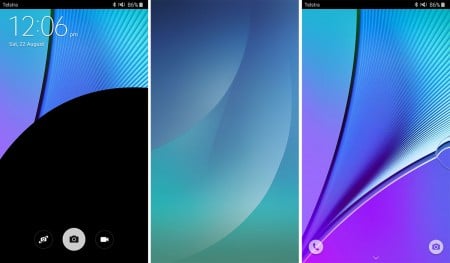Performance isn’t bad either, which doesn’t surprise us tremendously after seeing what it’s like-minded mostly-twin sibling can do, the Galaxy S6 Edge+.
Remember, the two are so close to being similar that outside of the pen and the slight design changes, you could easily think they were the same phone, and for the most part they are.
As such, the eight-core processor and 4GB RAM hums along in this phone, providing some of the quickest and snappiest smartphone experiences we’ve ever seen, and rarely raising an eyelid at the sign of problems.
The operating system and experience is also the same, with Samsung’s recent incarnation of a reduced overlay, or a lightened load, in any case.
Like on the S6 Edge, you’ll find this feels a little more like stock Android and a light version of TouchWiz, with several widgetised home screens, a drop down and customisable notification bar, and an app menu, and with this slightly lighter take on Android, as well as the previously mentioned combination of technology, the phone generally handles itself well.
There were a few, truth be told, with the occasional hiccup from the phone refusing to wake after a long charge, or jumping into the camera using the double-tap of the home button, but these hiccups appeared to be random, and it didn’t take long for the Note 5 to get back on track delivering one of the best and most stable smartphone experiences we’ve ever seen.

Mobile performance is on par with this, and that’s because Samsung has brought in the big guns for the 2015 phablets.
Just like we saw on the Galaxy S6 Edge+ — of which this phone has an awful lot in common with — you’ll find a Category 9 modem inside the handset, one of the first in the world, making it possible to download at speeds as high as 450Mbps if the network will allow you.
To put that in terms everyone can understand, this is a good 40 times what the average Australian can download at when connected on ADSL2+ (provided most Australians are connected at the average 8 to 12Mbps on that connection).
That 450Mbps is a maximum, and also translates to around 50 megabytes per second, though you probably won’t find too many persistent 450Mbps connections.
In fact, in our test around Sydney’s CBD on Telstra’s 4GX network, we found speeds situated mostly in the 70 to 150Mbps area, which is definitely fast enough for us, even if it didn’t quite touch the Category 9 hint of higher than 300Mbps speeds.
Still, you’d be hard pressed to be disappointed by these speeds, which could end up losing you data very quickly, so make sure you have plenty of that if you’re into your mobile data.
Battery, on the other hand, isn’t quite as strong as we were hoping, but manages to fit the expectation of one day of life, as is the case these days with flagship smartphones.
We’re still going to give top marks for phones that manage to go beyond a day and venture into the second without problems, and that’s definitely not the Galaxy Note 5, which will last your regular work day, but not too much beyond it.

Our test had us listening to music, making and receiving phone calls, surfing the web, social networking, taking photos, reading and writing emails, and generally using the phone over the course of a day, with one test with Bluetooth off and another with Bluetooth on, and in each situation, the battery hit roughly a day.
That’s not a full 24 hours, though it could manage that if Bluetooth were switched on, but you wouldn’t have too much life left at the 24 hour mark if we’re being honest, and you would definitely want to run — not walk — to your nearest fast charging plug, of which there is one left in the box.

Samsung has also thrown in support for fast wireless charging, a technology based on the QI wireless charging we’ve seen for a while now but that is a little faster, hence the name, so if you have one of these optional charge bays, you’ll charge super speedy and without cables.
We still haven’t been able to grab one yet, but Samsung Australia has told GadgetGuy that they are definitely coming to stores locally, it’s just a matter of when.













